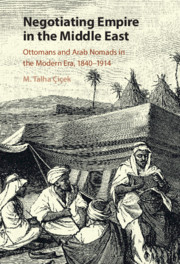Book contents
- Negotiating Empire in the Middle East
- Negotiating Empire in the Middle East
- Copyright page
- Dedication
- Contents
- Figures
- Maps
- Acknowledgements
- Note to the Reader
- Abbreviations
- Introduction
- 1 Conflict
- 2 Reinforcement
- 3 Expansion, Reaction and Reconciliation I
- 4 Expansion, Reaction and Reconciliation II
- 5 Partnership, Provincialization and Conflict
- 6 Taxation
- 7 Justice
- Conclusions
- Bibliography
- Index
2 - Reinforcement
Land Settlements and Military Fortification in the Desert and Its Frontiers, 1840–1870
Published online by Cambridge University Press: 08 July 2021
- Negotiating Empire in the Middle East
- Negotiating Empire in the Middle East
- Copyright page
- Dedication
- Contents
- Figures
- Maps
- Acknowledgements
- Note to the Reader
- Abbreviations
- Introduction
- 1 Conflict
- 2 Reinforcement
- 3 Expansion, Reaction and Reconciliation I
- 4 Expansion, Reaction and Reconciliation II
- 5 Partnership, Provincialization and Conflict
- 6 Taxation
- 7 Justice
- Conclusions
- Bibliography
- Index
Summary
This chapter examines the Ottoman efforts to reinforce the desert frontier with new settlements and collaborate with the chiefs of the settled tribes and local notables to gain their support in the form of provision of irregular soldiers. The new settlements could only make limited contributions to the imperial project of ‘cordoning the desert’ and it became necessary to compromise with the Shammar and Anizah even for the protection of the new settlements. In a similar way, the irregular troops under the command of the sheikhs of the settled tribes and the local notables, who were occasionally supported by the regular troops, organized military campaigns in the desert and its frontiers to defeat the tribes, which, in spite of temporary achievements, ultimately failed. Their failure to resolve the ‘nomadic question’ caused a revolutionary change in the structure of the desert troops: the replacement of irregulars with regular troops. In the early 1860s, this change led to the evolution of the Ottoman approach to secure the desert from organizing ‘exclusionist attacks’ into ‘regulatory security providing’ that comprised a fundamental aspect of reconciliation with the nomads and consented to the existence of the tribes in the lands they had occupied since the end of the eighteenth century as pasturage.
Keywords
- Type
- Chapter
- Information
- Negotiating Empire in the Middle EastOttomans and Arab Nomads in the Modern Era, 1840–1914, pp. 66 - 98Publisher: Cambridge University PressPrint publication year: 2021

